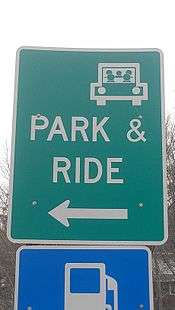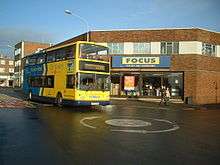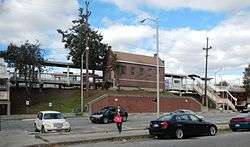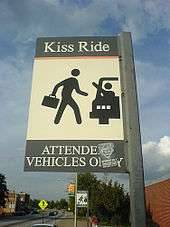Park and ride
Park-and-ride (or incentive parking) facilities are car parks with public transport connections that allow commuters and other people headed to city centres to leave their vehicles and transfer to a bus, rail system (rapid transit, light rail, or commuter rail), or carpool for the remainder of the journey. The vehicle is left in the car park during the day and retrieved when the owner returns. Park-and-rides are generally located in the suburbs of metropolitan areas or on the outer edges of large cities. Park-and-ride is abbreviated as "P+R" on road signs in the UK, and is also mentioned as P&R in colloquial speech and writing.
Adoption
In Sweden, a tax has been introduced on the benefit of free or cheap parking paid by an employer, if workers would otherwise have to pay.[1] The tax has reduced the number of workers driving into the inner city, and increased the usage of park-and-ride areas, especially in Stockholm. The introduction of a congestion tax in Stockholm has further increased the usage of park and ride.
In Prague, park-and-ride car parks are established near some metro and railway stations (about 17 parks near 12 metro stations and 3 train stations, in 2011).[2] These car parks offer low prices and all-day and return (2× 75 min) tickets including the public transport fare.[3][4]
Benefits
Park-and-ride facilities allow commuters to avoid a stressful drive along congested roads and a search for scarce, expensive city-centre parking. They may well reduce congestion by assisting the use of public transport in congested urban areas.


There is not much research on the pros and cons of park-and-ride schemes. It has been suggested that there is "a lack of clear-cut evidence for park-and-ride's widely assumed impact in reducing congestion".[5]
Park-and-ride facilities help commuters who live beyond practical walking distance from the railway station or bus stop. They may also suit commuters with alternative fuel vehicles, which often have reduced range, since the facility is probably closer to home than the ultimate destination. They also are useful as a fixed meeting place for those carsharing or carpooling or using "kiss and ride" (see below). Also, some transit operators use park-and-ride facilities to encourage more efficient driving practices by reserving parking spaces for low emission designs, high-occupancy vehicles, or carsharing.
Many park-and-rides have passenger waiting areas and/or toilets. Travel information, such as leaflets and posters, may be provided. At larger facilities, extra services such as a travel office, food shop, car wash, or cafeteria may be provided. These are often encouraged by municipal operators to encourage use of park and ride.
Criticism
British research suggests that the impact on congestion may be limited (especially if the buses have their own dedicated traffic lane). Looking at both the UK policy background and evidence from an award-winning scheme in Cambridge, Jonathan Manns notes "an Hellerian 'Catch‑22' situation, whereby the survival of local politicians is dependent upon its continuation, irrespective of its actual successes".
In Cambridge, it is suggested that "there does not appear to be evidence of an overall drop in vehicle flow within the city" and thus that "while cars parked at the park-and-ride sites are themselves no longer contributing towards the congestion externality, traffic flows are being generated elsewhere – for example, flows between car parks and homes from locals at whom the park-and-ride was not targeted but who nevertheless are attempting to commute to the service. This is significant in that while certain cars are removed from the flow, new flows are stimulated net of other individuals, thereby significantly negating the overall impact of the service".[5]
Bus park and rides

Park-and-ride facilities, with dedicated carparks and bus services, began in the 1960s in the UK. Oxford operated the first such scheme, initially with an experimental service operating part-time from a motel on the A34 in the 1960s and then on a full-time basis from 1973.[6] Better Choice Parking first offered an airport park-and-ride service at London Gatwick Airport in 1978.[7] Oxford now operates park and ride from 5 dedicated car parks around the city.[8] As of 2015, Oxford has the biggest urban park & ride network in the UK with a combined capacity of 5,031 car parking spaces.[9]
One of the largest park and rides in Saudi Arabia is located at Kudai in Mecca. It helps people go the Masjid al-Haram, There is a Shuttle Service operated by SAPTCO that takes people during Ramadan from the Kudai Parking to the Masjid al-Haram.
Railway park and rides
Some railway stations are promoted as a park-and-ride facility for a town some distance away, for instance Liskeard for Looe and Lelant Saltings for St Ives, both in Cornwall, England. Names of stations in the UK with large car parks outside the main urban area are often suffixed with "Parkway", such as Bristol Parkway, Tiverton Parkway, and Didcot Parkway. At Luton Airport Parkway and Southampton Airport Parkway, the stations are there to serve air as well as road passengers.

In the United States, it is common for outlying rail stations to include automobile parking, often with hundreds of spaces. Boston, for example, has built several large parking facilities at its commuter rail and metro stations near major highways and large arterial surface roads around the periphery of the city: Alewife, Braintree, Forest Hills, Hyde Park, Quincy Adams, Riverside, Route 128, Wellington, Woburn. The local transit operator, the MBTA, offers 46,000 park-and-ride spaces.
Bike and ride

B & R (B + R) is a name for using cycle boxes or racks near public transport terminals, mostly together with P & R car parks. This system can be promoted through integrated fare and tickets with public transport system.[10]
Kiss and ride


Many railway stations and airports feature an area in which cars can discharge and pick up passengers. These "kiss-and-ride" facilities allow drivers to stop and wait, instead of the longer-term parking associated with park-and-ride facilities.
The term first appeared in a 20 January 1956 report in the Los Angeles Times.[11] It refers to the nominal scenario whereby a passenger is driven to the station by spouse or partner; they kiss each other goodbye before the passenger catches the train.[11][12]
Some high-speed railway stations in Taiwan have signs outside stations reading "Kiss and Ride" in English, with Chinese characters above the words that read "temporary pick-up and drop-off zone". Most people in Taiwan have no idea what the colloquialism in English means.[13]
Also in Italy the new Bologna Centrale railway station uses the "kiss and ride" signs. [14]
Deutsche Bahn has announced that it will be changing the English expressions for Kiss and Ride, Service Points and Counters to German ones.[15]
Car-share park and rides
Park-and-ride schemes do not necessarily involve public transport. They can be provided to reduce the number of cars on the road by promoting carpooling, vanpooling,[16] and carsharing. Partly because of the concentration of riders, and thus a reduced number of vehicles, these park-and-ride terminals often have express transit services into the urban area, such as a high-occupancy vehicle lane. The service may take passengers in only one direction in the morning (typically towards a central business district) and in the opposite direction in the evening, with no or a limited number of trips available in the middle of the day. It is often not allowed to park at these locations overnight. These attributes vary from region to region.
See also
- List of Agence métropolitaine de transport park and ride lots
- Park and ride bus services in the United Kingdom
- Parking lot
| Wikimedia Commons has media related to Park and Ride. |
References
- ↑ "Skatteverkets skrivelse, Information om beskattning av parkeringsförmån" (in Swedish). Skatteverket. Retrieved 2012-01-19.
- ↑ "Aktuální obsazenost P+R | Dopravní podnik hlavního města Prahy" (in Czech). dpp.cz. Retrieved 2012-01-19.
- ↑ "TSK Praha - P+R" (in Czech). Tsk-praha.cz. Retrieved 2012-01-19.
- ↑ Petr Kvapil, Lira IS s.r.o., www.lirais.cz. "ROPID-Cestujeme…-P+R, B+R, K+R (od 1.7.2011)". Ropid.cz. Retrieved 2012-01-19.
- 1 2 "Park-and-ride - politics, policy and planning". Town and Country Planning Association. March 2010. Retrieved 2012-01-19.
- ↑ http://www.oxfordmail.co.uk/news/10859209.How_Oxford_led_the_way_to_create_Park_and_Rides/
- ↑ "BCP Company Information & Car Parks Offered". Airport Parking Shop. Retrieved 2012-01-19.
- ↑ http://www.oxfordbus.co.uk/content/doc/cms/companyhistory.pdf
- ↑ http://voyager.oxfordshire.gov.uk/Carpark.aspx
- ↑ "Doprava: Pražská integrovaná doprava a cyklisté". Doprava.praha-mesto.cz. 2005-06-22. Retrieved 2012-01-19.
- 1 2 "Transit Plan Agreement Smoked Out". Los Angeles Times. Associated Press. 20 January 1956. p. 4. Retrieved 2014-03-01.
- ↑ David Crystal (2003). The Cambridge Encyclopedia of the English Language. Cambridge University Press. p. 285. ISBN 0 521 53033 4.
- ↑ "Kiss and ride signs stump Taiwan rail passengers". Reuters. 5 February 2007. Retrieved 2007-09-27.
- ↑ "Alta velocità. Nella stazione di Bologna apre alle auto il Kiss and ride". Radio Città del Capo. 22 September 2014. Retrieved 2015-03-04.
- ↑ "German railways shunt English into sidings". BBC News. 16 February 2010. Retrieved 2010-02-17.
- ↑ "Park and Ride | Commuter Park'n'ride Options". Vride. Retrieved 21 September 2012.
|
